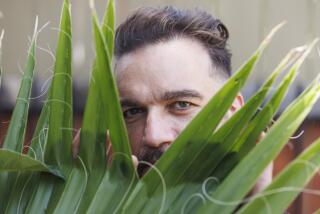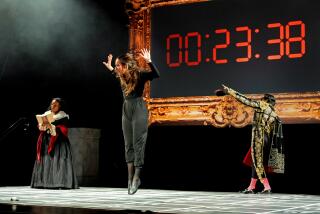‘My specialty is Gregorian chants. My wife used to call me the Mad Monk.’
- Share via
Don Curry, the organist at Forest Lawn Memorial Park in Glendale, is a dapper man.
He wears a blue blazer, slacks and a regimental tie. He’s square in the shoulder, straight in the back and precise of step. He keeps his thick, gray hair nicely combed down. He speaks in a clear British voice, and, with only so much as a word of provocation, he breaks into a schoolboy smile or even a laugh.
Altogether, he lends a burst of color to a world of black. He’s allowed that liberty because he is never seen.
He holds his job for life, which already covers quite a span. He’ll be 78 in January. He played his first funeral service Sept. 5, 1939. With the exception of 3 1/2 years during World War II, the show has been his ever since.
There is no way to add up how many people have accepted the bonds of matrimony or relinquished the ties of earthly life with his music in the background. For Curry, it was just a procession of working days.
“I got the record,” he said proudly one day on the job last week. “I did 13 services one Saturday.”
He counted out the starting times on his fingers, “9, 10, 11, 12, 1, 2, 3, 4:30, 5:30, 6:30, 8:30 and 9:30.”
That happened just after the war, he said. Servicemen were coming home and marrying the girls they left behind. There weren’t enough churches to handle the weddings. So they went to the flamboyant cemetery.
“It got too much when we’d play four funerals a day and then three weddings at night,” he said.
Curry has slacked off recently. He performs only about one service a day.
One day last week he played a medley of Episcopal hymns. He worked in a small room beside the altar of the Little Church of the Flowers, a 1916 replica of the church in Stoke Poges, England, thought to be where Thomas Gray wrote “Elegy Written in a Country Churchyard.” He sat at an antique-looking Estery console behind a curtain, opened just enough to allow him to see the casket. A man in black peeked into the doorway to give the sign when it was time to start.
Curry played efficiently, sending soaring melodies and rumbling bassos through the chapel, all with the same reserved movements of hands and feet. After 15 minutes, the man in black reappeared to tell him the mourners were seated.
Curry stepped out to an echoing anteroom, where he gave an impromptu account of his life and craft. He had studied music in England, then spent 5 1/2 years with the monks of St. John the Evangelist, studying the music of the liturgy.
Music finally exerted a greater pull than monasticism, though the two never fully disengaged.
“My specialty is Gregorian chants,” Curry said. “My wife used to call me the Mad Monk.”
The job has required both a sense of humor. Once, upon request, Curry played “Send in the Clowns” at the precise moment a family’s matrons sat down.
Curry added his own scholastic flourish. He has composed liturgical music and adapted hymns for the organ, a body of work for which he was awarded an honorary doctorate from Erasmus College in Surrey, England.
Curry came to Forest Lawn when it was still under the firm hand of Hubert Eaton, the conservative entrepreneur who built a tiny Glendale cemetery into a multimillion-dollar chain of memorial parks extravagantly outfitted with original and replicated art.
Nearly to his death in 1966, “the Old Man,” as Curry calls him, maintained two prohibitions: one against burying racial minorities and the other against playing recorded organ music. Curry played the organ at Eaton’s funeral and then played a personal role in breaking down both prohibitions.
As Southern California’s population diversified, Curry created a repertory of organ literature to keep pace with it. He transcribed Buddhist chants, Mexican folk songs, Greek and Russian hymns and Armenian chants for the organ.
Music as different from Protestant hymns as the Armenian chants required the application of music theory. “They don’t fit into the classical scales,” Curry said. “They’re modal, just the same as the Gregorian chants. I worked with the traditional Armenian chants and harmonized them in the Byzantine modes. Of course, they just loved it.”
The barrier against recorded music persisted under Eaton’s nephew, Fred Llewellyn, into the late ‘80s, Curry said.
“Then he got to thinking that the Old Man, meaning me, is getting on in years, and maybe he should record what he does,” Curry said.
The recordings started in 1987, about the time Curry’s wife of 45 years died. Now, Curry has a library of 20 tapes drawn from the liturgical music of the world. His current project is a Muslim recording.
He is waiting for the UNESCO library in Paris to send him tapes of the chanting of the Koran.
“I will study them and see if I can work the melodies in along with a few other things to make a Moslem tape,” he said.
Curry said he doesn’t intend to extend the collection into the standard repertory or vocal accompaniment.
“Giving the people taped music, that’s a freebie,” he said. “Why cut out the poor musicians? God knows they don’t get enough anyway.”
And, how could a tape play “Send in the Clowns” on cue?
More to Read
Sign up for Essential California
The most important California stories and recommendations in your inbox every morning.
You may occasionally receive promotional content from the Los Angeles Times.











